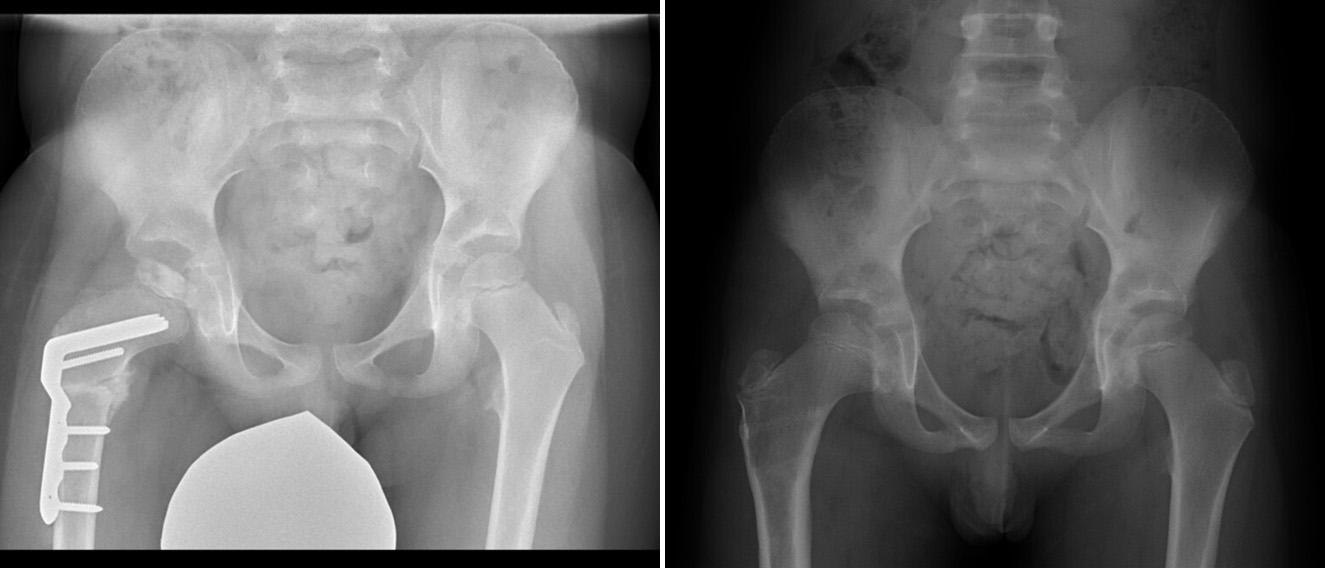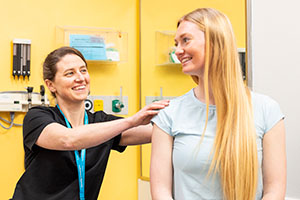Legg-Calvé-Perthes Disease
What is Legg-Calvé-Perthes disease?
Legg-Calvé-Perthes disease (LEG-cal-VAY-PER-theez) is a problem in the hip. It is often called Perthes disease.
This problem happens when blood stops flowing to the ball (femoral head) at the top of the thighbone that fits into the hip socket. Doctors do not know why this happens. If the bone does not get enough blood, it weakens and dies. Part of the bone may collapse and become flat. In rare cases, the ball no longer moves smoothly in the socket.
Over several months, the blood supply comes back to the bone. New bone cells slowly replace the dead bone. Based on the child’s age and how serious their condition is, this process may take 2 to 4 years.
Although any child can get Perthes disease, boys with the disease outnumber girls 4 to 1. Usually, they are thin, very active boys who are smaller than others their age.
The condition usually happens between the ages of 4 and 8, but it can happen as early as age 2 and as late as age 12. About 1 in 10 children who have had Perthes disease in 1 hip will also get it in the other hip, but it doesn’t happen in both hips at the same time.
Orthopedics and Sports Medicine at Seattle Children's
What are the symptoms of Perthes disease?
Children with Perthes disease often have a slight limp. In the early stages, they typically have a limp without any hip pain or soreness. Other symptoms include:
- Stiffness in the hip
- Pain in the knee, thigh or groin
- Limited range of motion in the hip
- Upper thigh muscles get smaller
- Legs appear to be different lengths
How is Perthes disease diagnosed?
Doctors look for a slight limp in your child’s walk, a common sign of Perthes disease. They also ask questions about any stiffness or pain your child might be feeling. Then they examine your child.
The doctor will gently move your child’s legs. They will compare the movement on the sore side with the movement on the other side.
Doctors may take to make sure Perthes disease is the problem. If the X-rays look normal, they may ask for a perfusion . This type of MRI can provide information about how much blood is flowing to the bone, which can help guide treatment.
How is Perthes disease treated?
For many years, doctors have been researching Perthes disease, looking for the best ways to encourage blood to return to the bone, speed recovery and get the best results for kids.
You child’s treatment will depend on their age and how bad their symptoms are.
Nonsurgical treatment for Perthes disease
The goals of nonsurgical treatment are to decrease symptoms as your child’s hip goes through the healing process and to prevent future hip problems.
Early in the healing process, it may be best to reduce your child’s activity and keep them from sports that are rough or may involve high impact on their hip. We often suggest children stay active with low-impact options, like yoga, cycling, swimming or rock climbing.
If symptoms keep happening or get worse, your child’s team may suggest having your child rest for short periods.
We may recommend using a brace to help maintain or improve range of motion in your child’s hip or using crutches (or a wheelchair for long distances) to take weight off their leg. Sometimes doctors use a brace to slow down a young child in an effort to improve pain and hip movement. Physical therapy may also help with pain and range of motion.
To reduce pain, doctors may recommend acetaminophen. In some cases, vitamin D and other medicines may improve bone healing.
Surgery for Perthes disease
 In early Perthes disease, surgeons may cut the bone (osteotomy) to direct the femoral head deeper into the hip socket and help stimulate blood flow and healing. They use an implant to hold the bone in place while it heals (left). The same hip fully healed after surgeons removed the implant (right).
In early Perthes disease, surgeons may cut the bone (osteotomy) to direct the femoral head deeper into the hip socket and help stimulate blood flow and healing. They use an implant to hold the bone in place while it heals (left). The same hip fully healed after surgeons removed the implant (right).
Based on their age and how serious their condition is, some children may benefit from surgery. The goal of surgery is to keep the femoral head from collapsing, improve range of motion and speed the return of blood flow for faster healing and better results.
Your child’s team may do surgery to:
- Tilt the ball so it is deeper in the socket
- Rotate the socket so it will cover the ball better when your child walks
- Release a tendon in the groin to improve range of motion
What to Expect After Treatment
During and after treatment for Perthes disease, the doctor will want to see your child and maybe take X-rays until your child is done growing.
Most children have no further problems. But sometimes a child has problems with the hip’s shape or function. As new bone fills in, the ball of their thighbone may become larger or flatter than before. As your child grows, the ball and socket reshape together, sometimes in ways that don’t lead to easy, pain-free movement. Some children may get early or get hip dysplasia or (also called hip impingement).
Your child’s team will check for signs of problems and also make sure you know what signs to watch for and when to call the doctor.
The team from Seattle Children’s Child and Young Adult Hip Preservation Program treats hip problems that might happen after Perthes disease. We focus on helping children and teens keep their natural hip and delay or avoid hip replacement. We also work with young adults in their 20s who are seeking care. For those who do need an artificial hip, we offer this option as well. Learn more.
Are there Seattle Children’s research or clinical trials for Perthes disease?
Seattle Children’s is part of the International Perthes Study Group, researching how to get the best results for children with this condition. We are involved in research testing new treatment methods, such as drilling holes in dead areas of bone or injecting some of a child’s own stem cells into the bone to try to promote healing.
Why choose Seattle Children’s for Perthes disease treatment?
Seattle Children’s Orthopedics and Sports Medicine team provides care for children, teens and young adults with Perthes disease. Within Orthopedics, experts from our Child and Young Adult Hip Preservation Program are involved to help protect or restore your child’s hip function.
-
The hip experts you need are here
- Your child’s team includes doctors, , and who specialize in children’s bones, muscles and joints. We have decades of experience treating Perthes disease.
- We involve specialists in , and , based on your child’s needs.
- Accurate diagnosis is the first step to effective treatment. Our team is experienced in making high-quality imaging studies using and .
- Dr. Todd Blumberg leads the Child and Young Adult Hip Preservation Program. He focuses on treating hip conditions from infancy into adulthood. Blumberg is the only dual fellowship-trained pediatric and hip preservation surgeon in the region. Seattle Children’s does more hip preservation surgeries for young people than any other center in the Pacific Northwest.
-
Our approach to surgery aims to get the best results for your child
- Before we recommend surgery, we look at your child as a whole person. Your child’s team will take many factors into account. These include how serious their condition is, the effects on their health, how much more they will grow and what results you can expect from treatment.
- We recommend surgery only when we believe it will give your child the best results. If your child needs surgery, our surgeons have many years of experience in treating children with Perthes disease. Each of our hip surgeons is . Many have expanded fellowship training.
- We have the technology and skills to use imaging to guide hip surgery, if needed. This lets us see in real time the changes we make to the hip. Our operating rooms have the newest, low-dose imaging equipment available.
-
Care from birth through young adulthood
- We specialize in caring for kids. This means our experts have the knowledge, training and skills to treat the youngest patients, from babies through young adults. Young people need treatment that takes their into account. Here, your child’s team has special training in the physical, emotional and social needs of young people.
- Babies, children and teens are still developing. When we evaluate your child’s condition, plan their treatment and provide their care, we carefully consider their growth. We think about how growth may affect their hip over time. We also consider how their hip may affect the rest of their development and health.
- If your child needs imaging that uses radiation, we use the lowest amount possible (PDF) to make the best image. We have a low-dose radiation X-ray machine, called the EOS. It makes safer full-body images. We also have the largest group of pediatric radiologists in the Northwest.
-
Support for your whole family
- Having a child with Perthes disease can be stressful for the whole family. From the first visit to follow-up, our team will work to give your child seamless care and make your experience here as easy on you as we can.
- Your child’s team does more than plan and provide care for your child. We also make sure you and your child understand your child’s condition and treatment options. We support you in making choices that are right for your family.
- For your convenience, our doctors see patients at locations in Seattle, Bellevue, Everett and Federal Way. We bring high-quality care closer to where you live.
- Seattle Children’s serves families from around the Northwest and beyond. We can help with financial counseling, education, housing, transportation, interpreter services, spiritual care and more. Our Child Life specialists, Family Resource Center and Guest Services are here to help. Read more about our services for patients and families.
-
Research and advances to improve care
- Our team members partner with experts around the world on research. Together, they work to understand the causes of hip conditions, improve the accuracy of diagnostic testing and create better surgical approaches.
- We are part of the International Perthes Study Group (IPSG). This group of researchers works to find out which treatments deliver the best outcomes for Perthes disease. We have IPSG clinical trials available at Seattle Children’s.
- We track long-term results of our patients so we can improve care for young people with hip problems. For example, we ask patients about their experience before and after treatment to make sure our approach improves quality of life and function.
- Our surgeons have led research to reduce your child’s exposure to radiation from imaging tests, like and .
- As part of our constant work to improve results for kids, we developed standard plans (called protocols) to help your child recover after surgery.
- Learn more about current orthopedics research at Seattle Children’s.
Contact Us
Contact Orthopedics and Sports Medicine at 206-987-2109 for an appointment, a second opinion or more information.
Providers, see how to refer a patient.
Related Links
- Child and Young Adult Hip Preservation Program
- Orthopedics and Sports Medicine
- More orthopedics resources
Paying for Care
Learn about paying for care at Seattle Children’s, including insurance coverage, billing and financial assistance.

